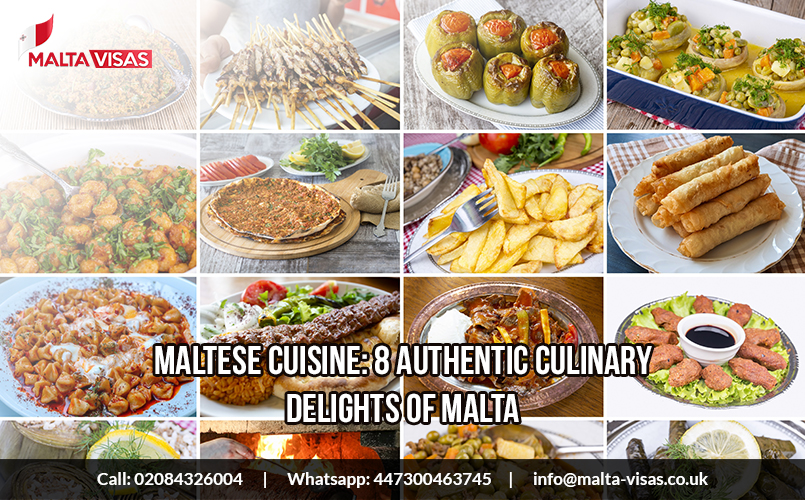
Maltese Cuisine: 8 Authentic Culinary Delights of Malta
Maltese cuisine is proof that a nation’s size has nothing to do with the scale of its flavours. Googling “what food to try in Malta” before a long-awaited holiday? Then, you need to know about the dishes that are both authentic and unforgettable. In fact, this guide answers that call by spotlighting the eight iconic dishes that the locals cherish and travellers rave about.
Furthermore, perched at the heart of the Mediterranean shipping lanes, Malta has spent millennia absorbing and remixing culinary ideas from passing civilisations. Subsequently, sicilian farmers supplied sun-sweet tomatoes and olive oil; on the other hand, North-African traders introduced fragrant spices and couscous-like grains; furthermore, British colonials left a legacy of savoury pies and comfort stews. In fact, the result is a small-i sland gastronomy with big, layered flavours. So, dive in, to check out how centuries of crossroads living have forged one of Europe’s most compelling food cultures with a Maltese Visa!
Quick Summary – This guide distils Maltese food culture into eight essential dishes—stuffat tal-fenek, lampuki pie, pastizzi, aljotta, kusksu bil-ful, timpana, bigilla and imqaret—explaining their origins, flavours, recipes, best eateries and peak seasons. In addition to this, informative tables, a Valletta 24-hour itinerary and drink pairings deliver a compact, travel-ready roadmap to Malta’s vibrant cuisine.
What to Expect from Maltese Cuisine? A Quick Overview
The cuisine of Malta is a fusion of Mediterranean flavors where Sicilian pasta skills, North African spices and British comfort food meet tomatoes, olives, capers and the daily catch of lampuki. Subsequently, shaped by millennia of conquest and Catholic feast days, the diet revolves around rustic stews, flaky street pastries and communal platters for sharing. In fact, seasonal eating is instinctive. On the other hand, recipes stretch scarce farmland produce with creativity and bold seasoning. Subsequently, this helps curate food that feels both familiar yet unmistakably Maltese.
| Core Ingredients | Culinary Influences | Eating Customs |
|---|---|---|
| Rabbit, lampuki, ġbejna cheese, tomatoes, olives, capers, broad beans, kunserva, Maltese olive oil | Phoenician trade, Arab irrigation & spices, Sicilian pasta culture, Knights of St John, British comfort food | Alfresco late dinners, Sunday family feasts, village festa banquets, street-food breakfasts, share-style antipasti, strict seasonality |
Did you know? Maltese food tourism witnessed a 29.5% increase in the recent years.
What are the 8 Best Maltese Foods You Must Try?
1. Stuffat tal-Fenek — Maltese Rabbit Stew
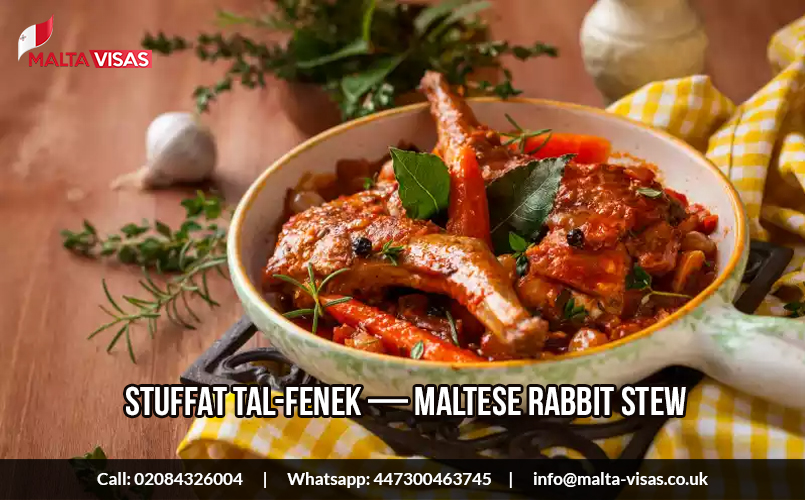
Malta’s national dish dates back to the Knights of St John, when hunting bans were lifted and rabbit became a sunday symbol of freedom and family. In fact, every village has its own red-wine stew ritual, always eaten with crusty ħobż.
Flavor Snapshot
- Rich, gamey meat
- Silky tomato-wine gravy
- Bay, allspice, garlic warmth
Where to Try Stuffat tal-Fenek in Malta?
- Diar il-Bniet, Dingli (€22)
- Il-Barri, Mġarr (€20)
- Ta’ Marija, Mosta (€23)
Insider Tip
By all means, pair this dish with a glass of Ġellewża red; also, it is best enjoyed in autumn when wild herbs are freshest.
Nutritional Byte
≈ 650 kcal per serving; 42 g protein, iron-rich.
Here’s a little-known fact – The locals in Malta consume roughly 2,000 metric tons of rabbit meat each year.
2. Lampuki Pie — Dolphin-Fish Pastie
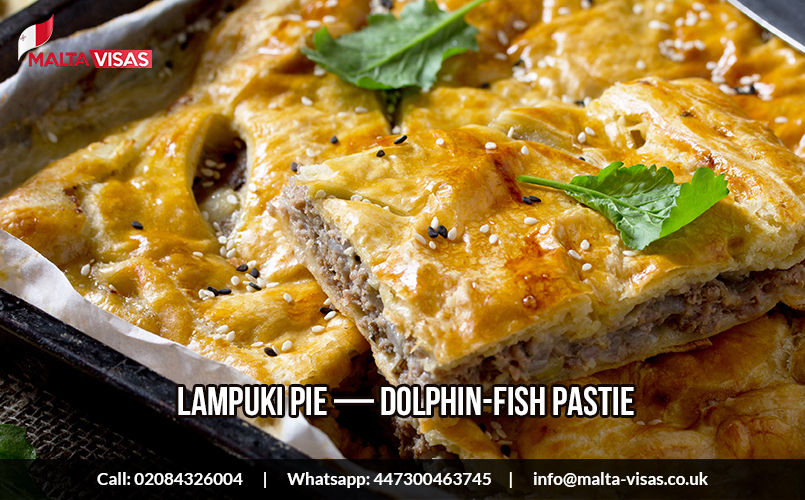
Lampuki fish migrate past the Malta each fall; in fact, fishers still use traditional palm-frond rafts to lure them. Subsequently, the locals use the fish to make a sweet-savory pie. Also, one interesting thing about this delight is that it ranks amongst the most sought-after Maltese cuisine dishes.
Flavor Snapshot
- Buttery pastry crunch
- Mild white fish, spinach earthiness
- Pops of caper brine and sultana sweetness
Where to Try Lampuki Pie in Malta?
- Gululu, Spinola Bay (€18)
- Ta’ Kris Bistro, Sliema (€17)
- The Harbour Club, Valletta (€22)
Insider Tip
Especially, order between September and December—the only months lampuki are legally landed. Also, a chilled Girgentina white pairs best with this dish.
Nutritional Byte
≈ 480 kcal slice; high in Omega-3s.
Are you aware that? Lampuki fishing employs around 140 traditional fishermen annual in the Malta.
3. Pastizzi — The Most Popular Dish of Maltese Cuisine
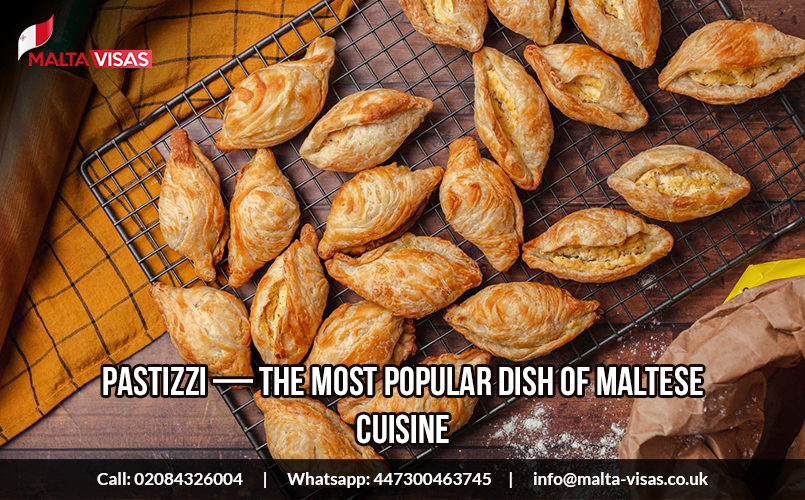
In fact, Pasitizzi is the Malta’s on-the-go breakfast since the 1800s. It is sold 24/7 from pastizzeriji and fuel-station kiosks. Also, the irresistible layers of this lard or the butter-rich pastry symbolize everyday indulgence for the locals and the holidaymakers.
Flavor Snapshot
- Shatteringly crisp shell
- Creamy, lightly salted ricotta core
- Optional curried pea version (piżelli)
Where to Try It in Malta
- Crystal Palace (Serkin), Rabat (€1)
- Sphinx Pastizzeria, Gżira (€1)
- Busy Bee, Msida (€1.20)
Insider Tip
Particularly, ask for “sejhba” if you like yours extra-browned. Moreover, the dish tastes best with a bittersweet Kinnie soda.
Nutritional Byte
≈ 280 kcal each; 17 g fat, vegetarian-friendly.
Did you know? – Particularly, the Pasitizzi dough involves folding the laminated pastry that can create about 100 thin layers!
4. Aljotta — Maltese Fisherman’s Soup
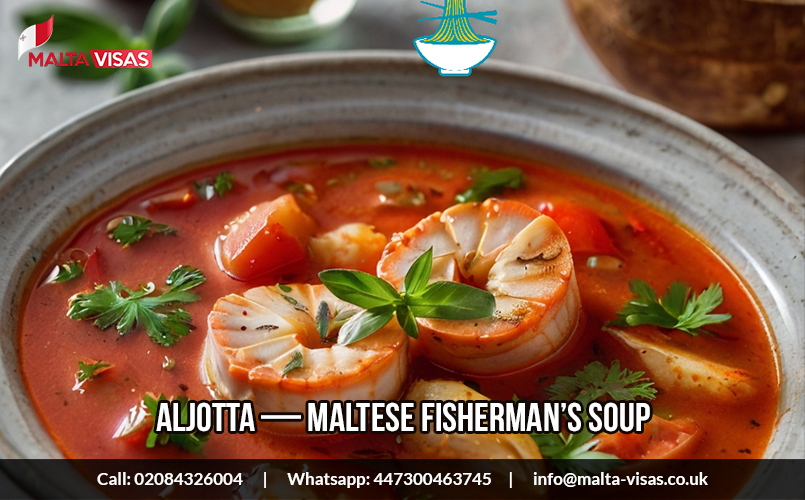
Specifically, rooted in Malta’s centuries-old fishing traditions, aljotta is a traditional Maltese fish soup. In fact, locals use the non-fillet parts of the fish (heads, tails, bones) into a garlicky flavourful stock. Also, this dish is best enjoyed during the Lent and on chilly boat nights. Subsequently, all you need to do is apply online Malta visa from the UK to start preparations for enjoying such authentic food of the Malta!
Flavor Snapshot
- Light, lemony broth
- Abundant garlic & parsley
- Delicate flakes of white fish
Where to Try Aljotta in Malta?
- Tartarun, Marsaxlokk (€12)
- La Nostra Padrona, Marsaxlokk (€11)
- Gululu, Spinola Bay (€10)
Insider Tip
Especially, squeeze extra lemon and drop in rice for a heartier meal. In fact, this is exactly how boat crews eat it.
Nutritional Byte
≈ 220 kcal bowl; low-fat, vitamin C boost.
5. Kusksu bil-Ful — Broad-Bean & Pasta Soup
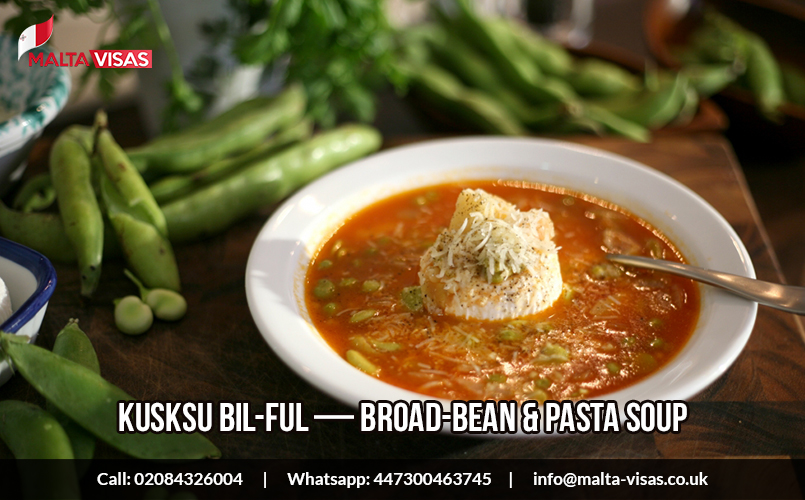
Particularly, the Kusksu bil-Ful is a springtime traditional soup of the Maltese cuisine. In fact, the dish uses Malta’s first broad-bean harvest and the iconic sheep-milk ġbejna. Also, this thick soup signals the end of winter and transition to the spring season making it one of the interesting traditional Maltese dishes.
Flavor Snapshot
- Creamy yet brothy
- Sweet young beans
- Melting peppered cheeselets
Where to Try Kusksu bil-Ful in Malta?
- Diar il-Bniet, Dingli (€9)
- Nenu the Artisan Baker, Valletta (€8)
- Farmers Bar, Żebbuġ (€7)
Insider Tip
Especially, for a vegetarian protein hit, crack an egg into the bowl. In fact, this is what the locals call as kusksu bil-bajd.
Nutritional Byte
≈ 350 kcal bowl; high fibre, 15 g protein.
6. Why Timpana is a Popular Food in Malta?
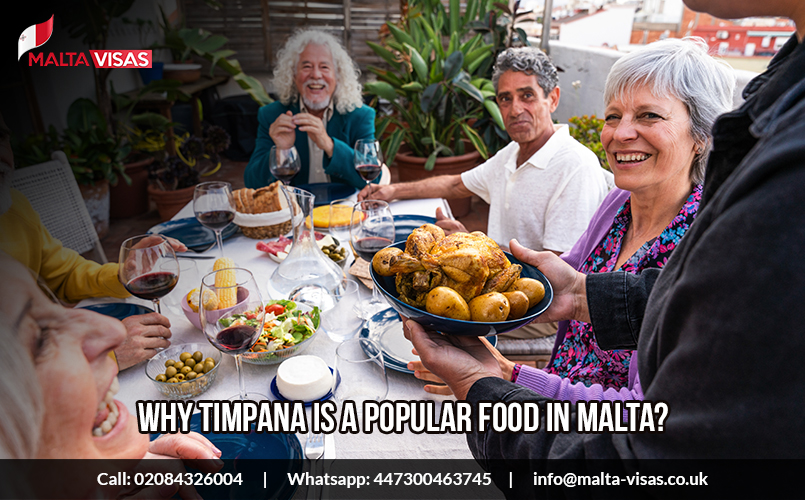
Introduced by Sicilian cooks serving the Knights, timpana is holiday comfort food which is essentially a Maltese baked pasta pie. Especially, relish this Bolognese-stuffed pasta baked inside the pastry if you are planning to have a snack while moving around.
Flavor Snapshot
- Crisp pastry shell
- Cheesy, tomato-meat macaroni
- Hint of clove & bay
Where to Timpana in Malta?
- Nenu the Artisan Baker, Valletta (€14)
- Maxokk Bakery, Gozo (€12)
- Ta’ Kris Bistro, Sliema (€15)
Insider Tip
Particularly, the locals eat leftover slices cold on beach days; In fact, it pairs brilliantly with Cisk lager.
Nutritional Byte
≈ 560 kcal slice; carb-dense energy bomb.
7. Bigilla — Rustic Bean Dip
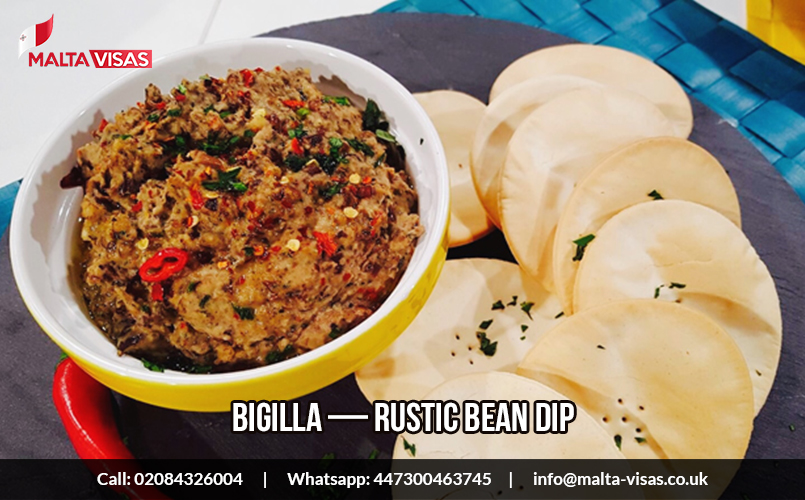
Specifically, the Bigilla turns the humble tic beans into Malta’s answer to hummus. That is because the Bigilla is essentially a delicious dip. Also, it is traditionally sold warm from street vendors and served with pickled onions at every bar. By trying Bigilla, you get to enjoy an authentic Maltese cuisine experience!
Flavor Snapshot
- Earthy, smoky mash
- Punch of garlic & marjoram
- Velvety yet gritty texture
Where to Try It in Malta
- Is-Suq tal-Belt Food Market, Valletta (€4)
- Ta’ Kris Bistro, Sliema (€5)
- Diar il-Bniet Deli, Dingli (€4)
Insider Tip
Particularly, spread bigilla on ftira (Maltese bread) and sprinkle with Maltese sea salt flakes. Also, add a drizzle of chili oil for a bar-snack upgrade.
Nutritional Byte
≈ 180 kcal per 50 g; protein-rich, vegan.
8. Imqaret — Date-Filled Fritters
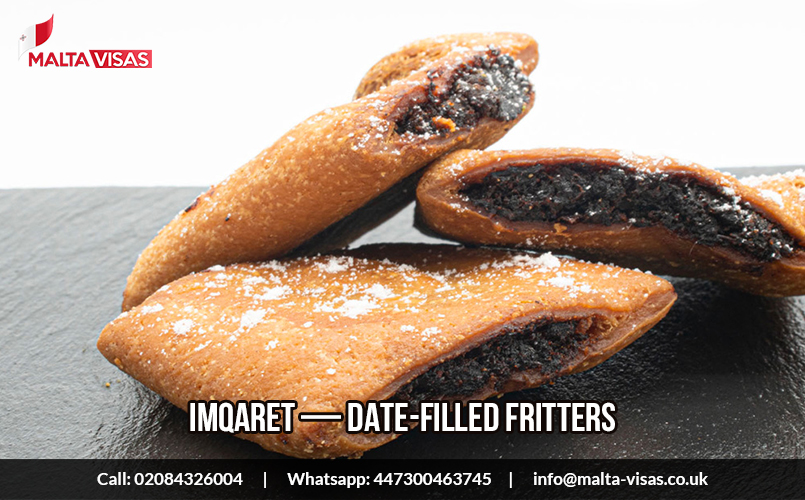
Particularly, the Arabic-era traders introduced date confections; furthermore, imqaret keeps that heritage alive at every festa, fried to order and perfuming streets with aniseed. Do not miss out on such popular dishes in Malta while visiting!
Flavor Snapshot
- Crispy outside, sticky center
- Fragrant with anise & citrus
- Pleasantly sweet, not cloying
Where to Try It in Malta
- Is-Serkin stall, Rabat (€1)
- Is-Suq tal-Belt, Valletta (€1.20)
- Open-air kiosks during Mdina Medieval Festival (€1)
Insider Tip
Especially, eat them piping hot with a scoop of ġelat tal-ħaxu (local carob ice cream).
Nutritional Byte
≈ 150 kcal each; high natural sugars, dairy-free.
Maltese Street-Food vs Home-Cooking – Quick Comparison
| Aspect | Maltese Street-Food | Maltese Home-Cooking |
|---|---|---|
| Flagship Dishes | Pastizzi, qassatat, imqaret, ħobż biż-żejt | Stuffat tal-Fenek, kusksu bil-ful, timpana, lampuki pie |
| Prep Time | 5–15 min; baked or fried in bulk | 1–3 hrs; slow stews, baked casseroles |
| Cooking Method | In general, high-heat ovens & deep-fryers for rapid turnover | In essence, simmering, braising, seasonal baking, low-and-slow techniques |
| Typical Venue | Especially, the pastizzerija kiosks, festa stalls, fuel stations | Particularly, the family kitchens, Sunday lunches, village feasts at home |
| When Eaten | Particularly, as breakfast, on-the-go snacks, late-night bites | Especially during the Weekend and feast-day meals; communal dinners |
| Portion & Price | Single-serve; €1–€3 | Family-style platters; €5–€10 per portion cost at home |
| Cultural Role | Particularly, these foods are a part of the everyday indulgence and social snacking | Especially, these foods facilitate the heritage preservation, family bonding, recipe heirlooms |
What are the Popular Maltese Drinks to Pair with Meals?
- Kinnie – Especially, the bittersweet chinotto-orange soda easily slices through the flaky fat; In fact, it is perfect with the sizzling Pastizzi on the go.
- Cisk – Significantly, sip the crisp, lightly hopped Maltese lager that refreshes between forkfuls of cheesy Timpana.
- Girgentina – Especially, try out the bright, mineral local white wine that lifts the mild richness of autumn’s Lampuki Pie.
- Bajtra – Particularly, relish the sweet prickly-pear Bajtra liqueur whose fruity notes echo the date filling of dessert Imqaret.
In case you didn’t know – The wine consumption in Malta was around 8,000 metric tons in 2023!
Seasonal & Festive Eating Calendar of Maltese Cuisine
| Season →Dish ↓ | Winter (Dec – Feb) | Spring (Mar – May) | Summer (Jun – Aug) | Autumn (Sep – Nov) |
|---|---|---|---|---|
| Stuffat tal-Fenek | ✓ Hearty, slow-cooked comfort for cool evenings | — | — | ✓ Served after the September hunting break |
| Lampuki Pie | — | — | — | ✓ Lampuki migration & village festivals (Sept–Dec) |
| Pastizzi | ✓ Hot breakfast on chilly mornings | ✓ | ✓ | ✓ |
| Aljotta | — | ✓ Traditional Lenten food | — | — |
| Kusksu bil-Ful | — | ✓ Broad-bean dishes season | — | — |
| Timpana | ✓ Christmas & Carnival favourite | — | — | — |
| Bigilla | — | — | ✓ Beach-bar dip with ftira | — |
| Imqaret | ✓ Christmas market staple | — | ✓ Festa street stalls | — |
Quick-Plan: 24-Hour Foodie Itinerary in Valletta, Malta
- 07:30 AM – Firstly, start at the Caffe Cordina on the Republic Square . Subsequently, enjoy a bite into the hot ricotta pastizz and pair up your dish with the lip-smacking Kinnie.
- 09:00 AM – Particularly, stroll to Is-Suq tal-Belt food market; especially, sample warm bigilla with crusty ħobż and an espresso pick-me-up.
- 11:00 AM – Furthermore, grab a street-side imqaret (date fritter) from the Merchant Street kiosk while walking toward the Upper Barrakka Gardens.
- 01:00 PM – Subsequently, have your lunch at Scoglitti by the Grand Harbour; in fact, order aljotta fish soup and a glass of chilled Girgentina white.
- 03:00 PM – Furthermore, digest with Maltese “te fit-tazza” (tea in a glass) at Café Berry on Old Bakery Street.
- 05:00 PM – Sunset aperitif: Especially, try out the Cisk lager and olives on the terrace of Bridge Bar overlooking Fort St Angelo.
- 07:30 PM – Subsequently, have your dinner at Nenu the Artisan Baker; especially, choose stuffat tal-fenek or a slab of timpana of Maltese cuisine, paired with Ġellewża red.
- 09:30 PM – Particularly, wander to Strait Street’s Yard 32 for a sweet Bajtra liqueur digestif.
- 11:00 PM – Night-owl snack: In essence, go for a second round of pastizzi (try the curried pea filling) from Valletta Pastizzeria near City Gate.
- 12:30 AM – Especially, catch live folk guitar at KuDeTa Lounge or live music bars on the Strait Street; in fact, relish another Cisk.
- 07:00 AM (next day) – Finally, end your food adventure in Valletta, Malta with a ftira sandwich stuffed with tuna, capers and kunserva from Grano Bakery before heading out.
Interesting fact – As a matter of fact, in 2024, the wine industry of the Malta produced grapes to the tune of 1,790 metric tons!
Conclusion
Maltese cuisine is far more than a roster of recipes—it is the living story of tiny islands that absorbed empires yet kept their own voice. Also, by chasing flaky pastizzi at dawn, spooning aljotta by the harbour, and lingering over slow-braised stuffat tal-fenek at sunset, you taste centuries of trade, faith and family tradition in a single day. Each of the eight dishes spotlighted here anchors a season, a festa or a childhood memory, proving that Malta’s food culture thrives on both scarcity and creative abundance.
Whether you follow the 24-hour Valletta itinerary or chart your own course through village bakeries and fishing ports, let seasonality guide your food adventure in Malta and pair local drinks to amplify every bite.
Couldn’t get a Malta Schengen Visa Appointment London because slots are getting booked quickly?
Then, you need help from a trusted partner like MALTA-VISAS. Our convenient online application coupled with lightning-fast appointment bookings ensure that you do not have to miss out on any dish of the Malta.
So, what are you waiting for? Apply now for a gastronomic experience in the Malta!

Key Takeaways:
- Savour the best of Malta’s cuisine through eight cornerstone dishes. In fact, the popular ones are the rabbit stew, lampuki pie, pastizzi and more.
- Trace layered influences of dishes from Arabs, Sicilians and Brits. In fact, these shape ingredients, flavours and cooking styles of Maltese cuisne.
- Time your tastings with the seasonality: Especially, try out the lampuki in autumn, broad-bean kusksu in spring, imqaret at festas.
- Pair local drinks wisely – especially, try the Kinnie with pastizzi, Girgentina white with fish, Bajtra liqueur for dessert.
FAQs
1). Is Maltese cuisine spicy?
Generally, no. Also, Maltese food leans on aromatic herbs like bay, marjoram, mint and parsley, plus garlic, citrus and the occasional hint of aniseed. In fact, hot chilli rarely appears outside modern fusion menus. Also, the island’s historic palate favours robust but gentle flavours.
2). Can vegetarians eat traditional Maltese food?
Yes, although meat and fish are prominent, several hallmark dishes are naturally meat-free. Also, try bigilla (tic-bean dip), kusksu bil-ful minus ġbejna, kapunata vegetable stew, ġbejniet cheese with local honey, and ħobż biż-żejt tomato bread. Pastizzi with ricotta also suits ovo-lacto vegetarians.
3). What is the difference between pastizzi and qassatat?
Both savoury pastries share popular pea or ricotta fillings, yet their crusts and shapes diverge. In fact, Pastizzi use wafer-thin, lard-laminated layers folded into diamond “ship” pockets that shatter on bite. Also, Qassatat rely on sturdier short-crust circles pinched at the top, yielding a softer, pie-like chew.
4). When is lampuki in season?
Lampuki—also called mahi-mahi—arrive with migrating shoals that skirt Malta from late August until early December. Local fishers still float palm-frond rafts to lure the fish beneath traditional luzzu boats. Also, outside this window, authentic lampuki pie is rarely found and menus substitute other white fish.
5). What cheese is unique to Malta?
Ġbejna is Malta’s signature cheeselet, traditionally made from sheep’s milk, rennet and sea salt then air-dried in open stone rooms. In fact, it comes fresh, peppered or dried hard enough to grate. The peppered variety often melts into kusksu soup, while dried ġbejna tops salads and pasta.



